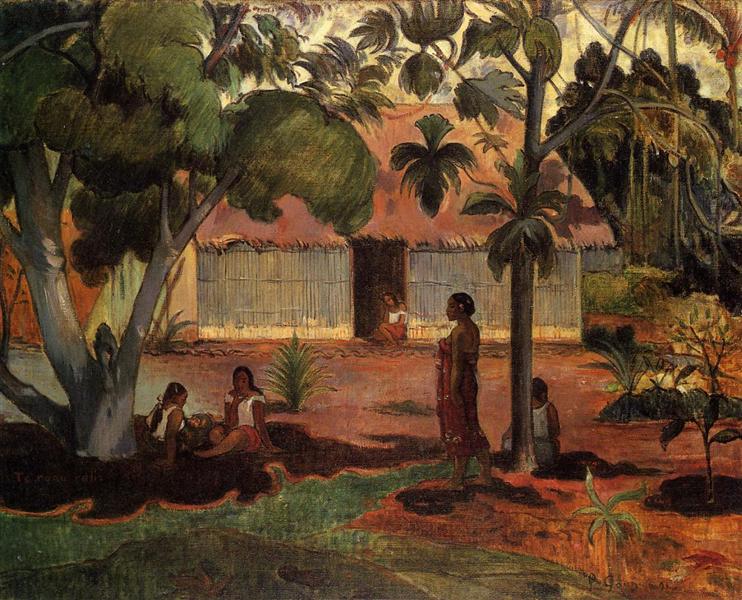Description
Paul Gauguin's "The Big Tree" (1891) is a fascinating representation of the artist's signature post-impressionist style. Illustrating a leafy tree surrounded by lush vegetation and an energetic background, the painting captures the essence of the relationship between nature and human emotion, a recurring theme in Gauguin's work.
From the first glance, the composition offers a visual unity that invites the viewer to explore its depth and rich color palette. At the center, the large tree stands with majestic grandeur, its wide branches reaching toward the sky, marking a contrast with the surrounding landscape. This arboreal figure, a deep green that blends with darker tones, is central to the visual structure of the painting. The tree’s bark, rendered with strokes of terracotta and brown colors, evokes a sense of life and echoes the natural textures that Gauguin sought to highlight.
The interaction between the tree and the immediate surroundings is significant. The background, although more abstract, is composed of a variety of greens that reflect the lushness of the tropics. Loose brushstrokes and intense application of color are distinctive features of Gauguin’s style, who often sought simplification of forms and an unconventional use of colors to convey emotions. This approach is evident in this work, where the landscape is presented not only as a setting, but as an almost metaphysical element that accompanies the tree.
Gauguin also uses a vibrant color scheme that reinforces the sense of the exotic and the emotional. Shades of green are contrasted with surfaces of yellow and blue, creating a sense of harmony that transcends the literal representation of nature. This use of color departs from naturalistic representation, pushing the viewer toward a more sensorial experience. Paul Gauguin, often seeking purity of color and form, here achieves a balance between the observed and the expressive.
Although The Great Tree does not feature human figures, the tree itself can be interpreted as a symbol of life, permanence, and connection to the earth. The fact that there are no characters in the scene allows the viewer to engage directly with the landscape, reflecting on their own existence and position within a vast and powerful natural world. This isolation of the human element aligns with the expressive intentions of Gauguin, who frequently departed from traditional figurative subject matter to explore concepts of spirituality and connection to nature.
The work suggests Gauguin's desire to explore new artistic directions, a move away from impressionist methods towards a more personal and symbolic interpretation of life. The artist had begun his journey towards a bolder and more exuberant style, influenced by his experiences in Tahiti, which is a constant in his career. Although this work predates his stay on the Polynesian island, one can already glimpse glimpses of the search for the primitive and the spiritual that would mark his later work.
Thus, The Big Tree becomes a visual testament to Gauguin’s evolution as an artist. Through the exuberance of its palette and the subtlety of its composition, the work establishes a dialogue with the viewer that is both intimate and universal. The connection between the tree and nature is not only visual, but also emotional, inviting each one to meditate on their own existence amidst the immensity of life. In this painting, as in many of his works, Gauguin challenges and delights, emotionally engaging the viewer and opening up new dimensions of interpretation and introspection.
KUADROS ©, a famous painting on your wall.
Hand-made oil painting reproductions, with the quality of professional artists and the distinctive seal of KUADROS ©.
Painting reproduction service with satisfaction guarantee. If you are not completely satisfied with the replica of your painting, we will refund 100% of your money.

